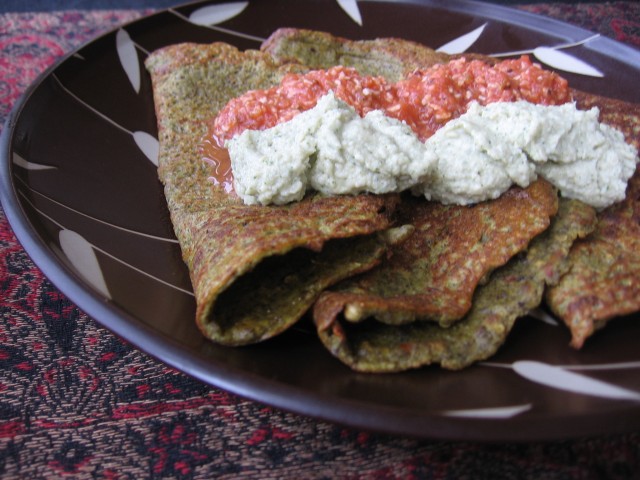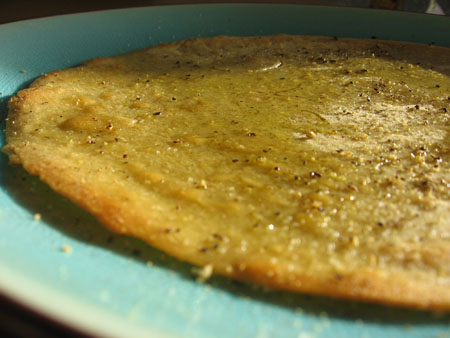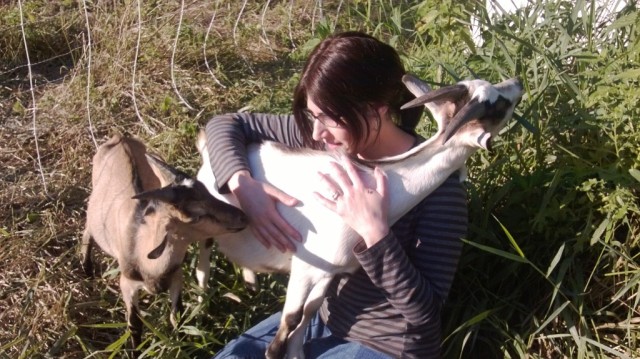These are my new addiction.
As part of my budget adventure, I’m trying to use up stuff from my pantry. (Well, more like I was too anxious about finances to go to the grocery store so I was forced to turn to the seldom-used items in my pantry…) Last week I came across a jar of mung dal (split mung beans) that I’d never cooked with, so I looked online to see what kind of recipes I could make.
I found a recipe for something called cheela, savoury Indian mung dal pancakes at the so-delicious-I-want-to-eat-everything-she-makes vegetarian blog Lisa’s Kitchen. I normally shy away from getting out my food processor except on special occasions (because I don’t like to wash it!) but I felt like having a little adventure, so I went for it. Little did I know I’d be washing the food processor three times that night… but it was totally worth it.
So these are ridiculously delicious and I never seem to get tired of them. The texture is somewhere between soft and crisp (softer than a dosa, much thinner than an uttapam) and they are flexible enough to fold in half without cracking. The flavor is remarkable, due mostly, I think, to the whole coriander seeds blended into the batter. They are dry enough that they definitely need some kind of moistening accompaniment. I went with the cashew chutney Lisa recommends on her blog and improvised a tomato-coconut chutney as well (recipe follows). Both were super delicious, although the cashew chutney is incredibly rich (and not particularly budget-y) so now that I eat these all the darn time I’ve just been topping them with the tomato chutney.
I keep a container of the batter in the fridge. It makes an easy protein-and-fiber breakfast every morning, and an excellent quick (cheap!) snack to reach for when I have guests who need to be fed pronto (like this afternoon when Farmer B came over to make sauerkraut). When the batter is close to running out, I set out another cup of mung dal to soak, then a few hours later get out my food processor and make another batch. I make them in a cast iron pan with just a tiny bit of oil, so as far as I can tell they’re a fairly guilt-free indulgence, too. (Although the first time I made them, I didn’t have any soy yogurt, so I improvised “yogurt” using cashew butter, almond milk, and vegan cream cheese. As Duck said, it was probably the most expensive yogurt substitute ever made!)
Cheela ~ Savoury mung dal pancakes
This recipe is from the blog Lisa’s Kitchen. I have adapted it very slightly – made it vegan, added the dried chiles at an earlier step to save washing another bowl, used less oil. This means the recipe is that much further away from authentic. But it’s the version I’ve been eating every day, so it’s the one I can highly recommend!
1 cup split mung beans without skins (mine were split but had skins and turned out fine)
1/2 cup soy yogurt (did you know you can freeze soy yogurt? I freeze it in 1/2 cup portions in ziploc bags to use for this recipe)
2 tablespoons coriander seeds
1 tablespoon fennel seeds
1 teaspoon sea salt
1/2 teaspoon asafoetida
1/4 teaspoon turmeric
1/3 cup water
4 dried red chillies, or to taste (I used a combo of tobagos and red chiles)
Olive or canola oil for cooking
Rinse the dal thoroughly under cold running water, then place in a bowl and cover with water so that there are several inches of water above the dal. Soak for at least 3 hours or overnight, then drain and discard the soaking water.
Put the soaked dal in a food processor or blender and blend for several minutes, stopping now and then to push the dal down with a spatula. (It may take a while to get to the fine consistency you want to achieve, but don’t give up!)
Add the soy yogurt, coriander and fennel seeds, salt, asafoetida turmeric, and dried chiles and blend for another minute. Add enough water to make the batter thickish, like a lightly whipped cream.
Preheat a 10-inch frying pan or cast-iron pan over medium-low heat for 2-3 minutes. Sprinkle a few drops of water on the pan to test the temperature — if it is just right, the drops will dance and sputter before vanishing. If the drops vanish right away, turn down the temperature slightly, or if the drops just sit on the surface before boiling, turn up the temperature slightly. Brush the surface with a light film of olive or canola oil.
Scoop slightly more than ¼ cup of the batter and place on the middle of the pan.Place the bottom of a ladle or large spoon in the centre of the batter and spread it outwards in a continuous spiral, pressing lightly, until you have a thin round or oval pancake. Cook for 1 minute.
Cover the pan and cook for 3-4 minutes until the bottom is golden to reddish-brown. Loosen the edges with a spatula and turn the pancake over. Cook, uncovered, for another minute or so, then flip over once again, fold the pancake in half and slip it out of the pan on to a warming plate or into an oven preheated to 150° while you repeat the process. Repeat the water sprinkling to test the temperature and brush the pan with more oil before making each pancake. Makes 9 or 10 pancakes.
Serve hot, or store wrapped in aluminum foil and reheated in a 350° oven.
Serve with cashew chutney and tomato-coconut chutney, or some other moistening accompaniment/sauce.
Quick and easy tomato-coconut chutney
1 can diced tomatoes (those fire-roasted ones would be amazing here)
1/2 cup dried coconut
a sprinkle of cayenne
1 large chile (or more, to taste)
a sprinkle of asofetida
1 T. grated ginger
2 tsp. canola oil
2-3 tsp cumin seeds
2 tsp mustard seeds
Into a food processor: the can of tomatoes, dried coconut, cayenne, chile (fresh or dried), asafetida, ginger. Don’t process yet.
Heat the canola oil in a pan over high heat. Add the cumin and mustard seeds (and cover with a spatter screen if you’ve got one). When the spices stop sputtering, pour them into your food processor as well. Process until you reach your desired texture (chunky or smooth).



















